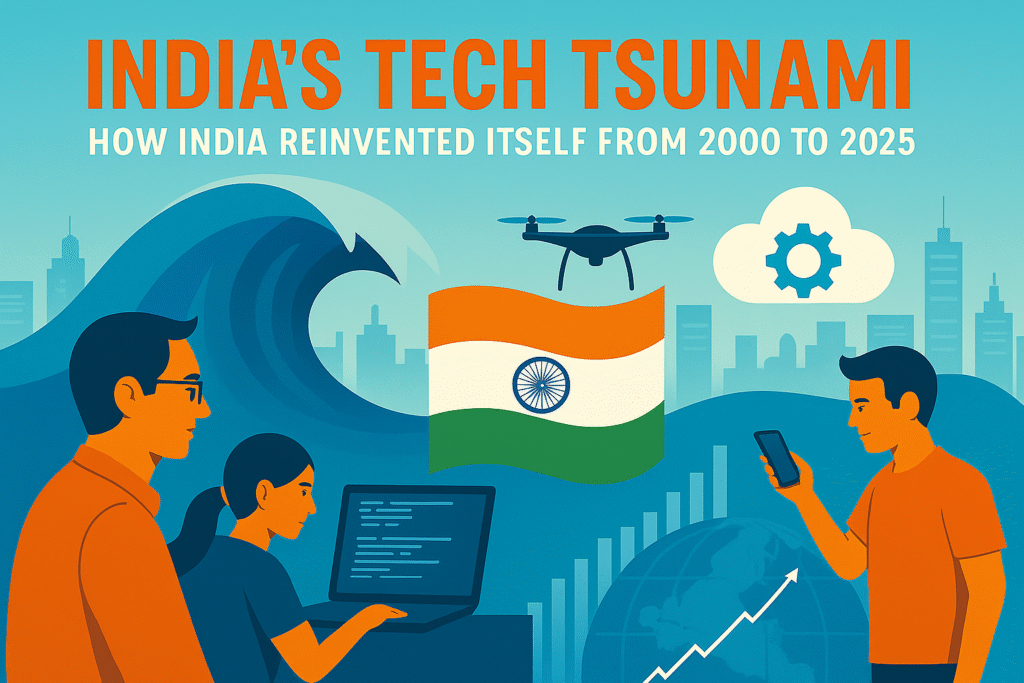
22 crore applications, 7.22 lakh selections. That’s less than 0.33%.
This staggering statistic from 2014 to 2022 paints a grim picture of India’s government job landscape. Despite a booming economy and an expanding private sector, millions of young Indians continue to chase the elusive dream of a government job. But is this pursuit draining the time, energy, and potential of our youth? This article dives deep into the obsession with government jobs, its impact on India’s youth, and the need to shift focus toward private sector opportunities and entrepreneurship.
The Sarkari Naukri Syndrome: A Deep Dive
Historical Context
India’s love affair with government jobs dates back to the colonial era. British administrative structures rewarded those who qualified for clerical and administrative roles with prestige, security, and lifelong pensions. Post-independence, the government remained the largest employer, and the legacy of government service as the ultimate aspiration endured. In the decades that followed, these jobs were seen as symbols of stability, particularly in rural and semi-urban areas.
Current Data and Competition
From 2014 to 2022, over 22 crore applications were received for central government jobs, while only 7.22 lakh candidates were selected. For the UPSC Civil Services Exam alone, over 1.3 million aspirants compete for a mere 800 to 1000 vacancies annually. In Uttar Pradesh, 48 lakh applicants recently competed for just 60,244 constable posts. That means nearly 80 candidates per post. This unprecedented competition underscores the level of desperation and the intense psychological pressure that accompanies these examinations.
Why the Obsession?
Job Security
For decades, government jobs have represented long-term security. With minimal chances of layoffs, defined work hours, and guaranteed pensions, they are understandably attractive, especially in a volatile job market. For many, it’s less about passion and more about risk aversion.
Perks and Benefits
From subsidized housing and healthcare to travel allowances and pensions, the benefits offered are substantial. Furthermore, the 7th Pay Commission revisions significantly increased salaries, making them competitive with private-sector roles in Tier 2 and Tier 3 cities.
Social Prestige and Parental Pressure
In Indian society, a government job is often equated with respectability, especially in matrimonial markets. Parents push their children toward this path to elevate their family’s social standing. In many cases, a government employee is considered a more desirable marriage prospect than even a private-sector engineer or MBA.
Lack of Awareness and Exposure
Many youth, especially from non-urban backgrounds, are unaware of the diverse career opportunities in the private sector, startups, or freelance work. Government jobs are often the only career path they’ve ever heard praised or encouraged.
The Opportunity Cost: Years Lost in the Grind
Time Investment
A typical UPSC aspirant prepares for 3-5 years. Many appear for 3-6 attempts, some even longer. During this period, they often do not work, do not build professional skills, and remain economically dependent. These are years when one could be gaining industry experience, upskilling, or building a business. For example, a 24-year-old graduate may begin preparing for government exams immediately after college and continue till the age of 29, hoping to crack one of the few elite positions. In those five years, a peer working in the private sector could have gained promotions, built a portfolio, invested in mutual funds, or even launched a startup.
This lost time isn’t just personal. It’s a national concern. If millions of young Indians delay their entry into the productive workforce, the demographic dividend we often talk about becomes a liability. The economy loses skilled contributors. Innovations stall. Growth slows.
Emotional and Mental Health Toll
The psychological burden of competitive exams is immense. Imagine spending years in isolation, under constant pressure, with your self-worth tied to an exam result. Repeated failures erode confidence. For many, identity and purpose are built around these exams. When they don’t succeed, they face not only personal disappointment but social stigma.
Mental health issues such as anxiety, depression, and burnout are common. In extreme cases, aspirants suffer emotional breakdowns. Coaching hubs like Mukherjee Nagar in Delhi and Rajinder Nagar, once considered meccas of preparation, have also become spaces where dreams collapse under unbearable weight. Suicide rates among aspirants are a growing concern, but often brushed under the rug.
Financial Drain
The government job grind is not just emotionally taxing, it’s financially draining. Coaching classes charge anywhere between Rs 50,000 to Rs 2 lakh per course. Aspirants often attend multiple courses for different subjects and exams. Accommodation and living costs in cities like Delhi, Allahabad, and Hyderabad can add Rs 10,000 to Rs 20,000 monthly. Over 3-5 years, families may end up spending upwards of Rs 10 lakh.
This burden is even more acute for lower-middle-class and rural families. Many take loans, mortgage assets, or rely on siblings to fund the aspirant. If the candidate doesn’t succeed, the entire family’s financial health deteriorates. Contrast this with the same investment made in a business, a skill-based certification, or even mutual funds – and the opportunity cost becomes starkly evident.
In the pursuit of job security, lakhs are spent, but ironically, income is postponed.
The Illusion of Government Employment for All
Government’s Own Admission
According to a 2023 statement by the Department of Personnel and Training (DoPT), “It is neither feasible nor desirable for the government to be the sole provider of employment.” The government’s role is increasingly being redefined to that of an enabler, not a provider.
Limited Job Creation
India’s central government employs about 30 lakh people, and this number has remained almost stagnant. Many positions remain vacant due to budget constraints or efficiency drives. State governments face fiscal deficits and are unable to expand employment significantly. So where will new government jobs come from?
Technological Displacement
With digital governance initiatives like e-office, automation, and AI adoption, many clerical and middle-tier government jobs are being eliminated or merged. In the next decade, government hiring may shrink, not grow.
The Private Sector: A World of Untapped Potential
Real Demand
In FY24, the National Career Service portal showed 1.09 crore job vacancies, with only 87.27 lakh applications. In contrast to the mad rush for sarkari jobs, private sector roles are often undersubscribed.
Startup Ecosystem
India is now the third-largest startup ecosystem in the world. With 100+ unicorns and over 90,000 startups, opportunities abound in sectors like fintech, healthtech, edtech, and SaaS. These are spaces where the youth can not only find jobs but build careers that are dynamic, innovative, and impactful.
Skill-Based Hiring
Private firms increasingly value skills over degrees. Platforms like LinkedIn, Upwork, and Naukri have transformed how youth can access employment. Fields like data science, cybersecurity, content creation, and UI/UX design are booming with opportunities.
Higher Earnings Potential
While government jobs offer stability, they often have a salary ceiling. In contrast, private-sector roles, especially in IT, consulting, and finance, can offer higher starting salaries, quicker promotions, and performance-based incentives.
Entrepreneurship: The Ultimate Self-Employment
Government Support Exists
Despite the perception that only government jobs are secure, the Indian government has launched multiple schemes to boost entrepreneurship:
- Startup India
- Stand-Up India
- MUDRA Loans
- Atmanirbhar Bharat
These initiatives provide funding, incubation, and mentorship to young entrepreneurs.
Role Models Are Emerging
From Zerodha’s Nithin Kamath to Nykaa’s Falguni Nayar, Indian entrepreneurs are becoming household names. They offer relatable success stories to inspire youth.
Freelancing and the Gig Economy
With the rise of digital platforms, freelancing has exploded. A young designer, programmer, or digital marketer can now earn more than an entry-level government clerk, all from their laptop.
Reimagining Aspirations: What Needs to Change?
Educational Reform
Our education system must pivot from rote learning to creativity, problem-solving, and real-world skills. Career counselling, exposure to startups, and industry tie-ups in colleges can help broaden perspectives.
Societal Mindset Shift
Parents, teachers, and community elders must stop glorifying only government jobs. Success should be redefined to include innovation, social impact, and entrepreneurial risk-taking.
Media and Popular Culture
Indian TV shows, films, and news channels often glamorize IAS officers or government servants. It’s time they also highlight startup founders, coders, and changemakers.
Conclusion: Time for a Reality Check
The hard truth is: the Indian government cannot provide jobs for all. Nor should it. As the economy grows, the private sector and self-employment avenues must take center stage. The youth must be encouraged to pursue paths that align with their passion, skill, and potential — not just social prestige.
If India is to reap its demographic dividend, it must liberate its youth from the government job trap and empower them to build, innovate, and lead in a dynamic, modern economy.
Sources:
- Indian Express: 22 crore applications for govt jobs (2014-22)
- UPSC Annual Report (2023)
- National Career Service (NCS) Portal Data FY24
- Ministry of Skill Development and Entrepreneurship Reports
- Startup India, Stand-Up India, MUDRA scheme data
- Economic Survey of India


